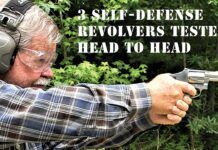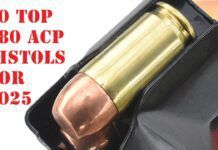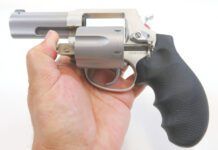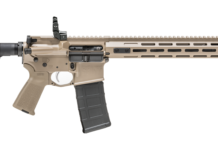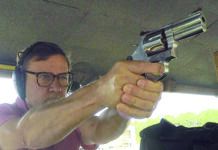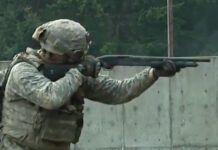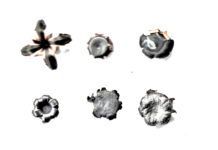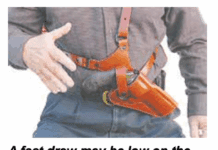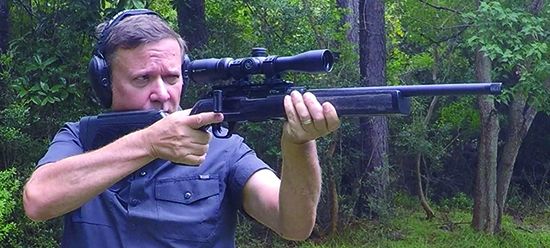Shooting 22 LR bolt-action rifles keeps you grounded. They are affordable to shoot often because ammo costs a fraction of what centerfire ammo does and lacks the noise, muzzle blast, and recoil. Not only is shooting a 22 rimfire inexpensive and fun, it also helps build a solid base in rifle-shooting technique, from trigger control and breathing, to judging distance and reading the wind. Three new target-style 22 LR bolt actions that we thought would be fun to shoot were the Springfield Armory 2020 Rimfire, Savage’s B Series TimberLite Thumbhole, and the Hammerli Arms Force B1. All of these rifles were recently introduced and are said to provide performance and accuracy. The common characteristics of these three rimfire rifles are the 22 LR round, manually operated bolt actions, detachable rotary magazines, and they are optic ready. From there, the features start to differ.
How We Tested
For the last few rimfire rifle reviews, we used either a Vortex Crossfire II 2-7x32mm rimfire SFP scope ($149) with a simple V-Plex MOA reticle similar to a Duplex reticle and a Hawke Vantage IR 3-9x40mm scope ($159), which is equipped with a Rimfire 22 HV reticle for long-distance shooting. We like both of these scopes for their performance and cost. They are just enough scope for plinking and hunting. For optics placement, the Springfield and Hammerli are equipped with Picatinny rails, and the Savage sported a Weaver rail, so mounting the scopes was not a chore.
After zeroing the rifles at 50 yards, we fired from a bench using a rest and a toe bag to gather accuracy data from three-shot groups. Because Springfield’s 2020 Rimfire has a 1-inch accuracy guarantee for three shots at 50 yards, we used that standard for all the rifles, which was not hard for any of these rifles to achieve with inexpensive and target ammo. We also fired the rifles off hand. Ammunition ranged from inexpensive CCI Blazer with a 38-grain lead round-nose bullet, to target ammo, namely, Remington Target with a 40-grain solid lead bullet and Eley Tenex, likewise loaded with a 40-grain lead bullet and a light lubricant. Here’s what we found.
Hammerli Arms Force B1 Model 5800300 22 LR
$672
Gun Tests grade: A-
The Force B1 rifle is unique with the pull/push action. It offers a lot of versatility with the ability to swap out barrels. We liked that the B1 was compatible with aftermarket Ruger 10/22 triggers and magazines. Accuracy was stellar at times, and then it wasn’t. We didn’t care for the trigger.

| Action Type | Bolt |
|---|---|
| Overall Length | 37.4 in. |
| Barrel Length | 16.1 in. |
| Barrel Twist Rate | 1:16 in. |
| Muzzle | Threaded, ½x28 tpi, w/cover |
| Sights | Optics ready, integrated Picatinny rail |
| Weight Unloaded | 5.7 lbs. |
| Weight Loaded | 5.8 lbs. |
| Stock | Laminated wood, gray |
| LOP | 14.6 to 16.6 in. |
| Buttplate | Rubber |
| Action Finish | Blued |
| Barrel Finish | Blued |
| Magazine Type | Detachable, Ruger-style rotary 10-rd. box |
| Magazines, Additional | $17-$19 each* |
| Trigger Pull Weight | 5.5 lbs. |
| Safety | Manual thumb |
| Accuracy Guarantee | None stated |
| Warranty | Lifetime |
| Telephone | (497) 242-8500 |
| Website | HammerliArms.com |
| Made In | Germany |
*TheMagShack.com
The Force B1 was introduced in early 2024 by Hammerli Arms, a firearms company known for accurate rimfire target rifles and pistols. The company was originally established in Switzerland, but it is now owned by Umarex and produces air guns and firearms in Germany. The B1 is a unique rimfire rifle. It is a multi-caliber rimfire with the capability of swapping out barrels chambered in 17 HMR, 22 LR, and 22 WMR. The barrels are easily swapped by pulling back on the knurled collar in front of the action and pulling out the barrel. A tab in the action aligns with a cutout in the rear of the barrel, so the two parts mate the same way every time. All barrels come threaded. The magwell is designed to take the longer 22 WMR and 17 HMR Ruger rotary-style magazines. An adaptor, three are included with the rifle, snaps onto Ruger 22 LR rotary magazines. We think this is a very clever design, and it is versatile.
The second unique feature about the Force B1 is the action, which uses a straight-pull toggle bolt action. These types of actions are found on biathlon rifles, like those built by Anschütz, but the B1 looks more like the Volquartsen Summit rifle. These actions offer fast operation with a pull-push bolt-cycling technique that does not disturb the shooter’s line of sight like a traditional bolt action can. With the B1, you open the bolt by pulling back on the toggle handle and then pushing it forward, so the movement of the rifle is back into your shoulder then forward toward the target. The bolt handle is a vertical paddle with smooth edges. We found we needed to smartly operate the bolt to get it in and out of battery. It is not as slick and fast operating as biathlon rifles. The cycling was, however, smoother than a traditional bolt action. There are three different stages: 1) Cycle the bolt open out of battery, creating mild resistance; then 2) pull the bolt fully rearward to smoothly eject the case; and 3) push the bolt forward to chamber a round, locking the bolt back into battery.
The receiver reminded us of a Ruger 10/22, and it in fact is adaptable with Ruger aftermarket triggers, which we think is a good thing because we did not care for the B1’s trigger. It was not adjustable and broke at 5.5 pounds. Really, on a target rifle? It has a safety paddle built into the face like a Savage AccuTrigger or Mossberg Lightning trigger. The front edge of the B1’s safety paddle had a sharp point that pricked us numerous times. There is also a crossbolt safety built into the front of trigger guard. The top of the receiver is fitted with a Picatinny rail, so mounting an optic is simple and easy. The magazine release is forward of the trigger guard and ergonomic to operate.
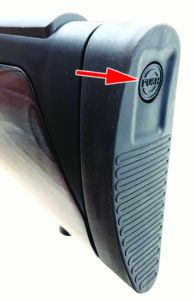
The target-style stock was mostly laminated wood, though there are polymer variants. We thought the stock looked good. The Hammerli logo was laser engraved in two places in case we forgot what rifle we were shooting — in the pistol-grip cap and the top of the stock behind the receiver. The pistol grip is vertical and very comfortable to shoot prone, sitting, or standing. The bottom edge of fore end is flat for better stability shooting off a rest. It has a M-Lok rail embedded in it to attach a bipod or sling swivels. Both the grip and fore end are stippled for a sure grip without being too aggressive. The stock length of pull is adjustable via a button in the butt. There are six locking positions. The comb or cheek rest is also adjustable, which is helpful when mounting optics. The rubber comb is reversible and tightly fits into a slot in the comb. We thought the stock was a clever design and allowed for whatever optic setup you wanted and whatever stature of a shooter you are. It did not seem as rugged as a classic rimfire-rifle stock, but we don’t think we will be jumping out of helicopters with the Force B1. The rifle was also light weight at 5.7 pounds without an optic.
The B1 disassembles a lot like a Ruger 10/22, so a hex wrench is needed to remove the action from the stock. The ability to remove the Hammerli barrel means it is easier to scrub the bore than a on a traditional Ruger 10/22.
Going hot, we were stunned with the accuracy using inexpensive Blazer ammo. A 0.11-inch three-shot first group was incredibly nice. On average, the Blazer drilled 0.25-inch three-shot groups. However, the other two ammo choices deflated our accuracy enthusiasm. The Eley Tenex gave a best group that measured 0.40 inch; average was 0.66 inch. Remington Target’s best was 0.77 inch; 0.82 inch on average. Across all ammo, the average accuracy was 0.57 inch, which was well under the Springfield Armory accuracy-guarantee benchmark. We thought the accuracy was very good, especially from a lightweight rifle with a mediocre trigger. We also removed the barrel and replaced the barrel and saw no shift in point of impact. Like all 22 LR rimfire fodder, you will need to try a variety of ammo and stick with the brand and weight that works best.
The straight-pull action required swift movement and was smooth to operate. It still affected our sight picture, but not as much as a traditional bolt-action movement. The buttpad was a bit tacky and stuck to our shirt. Reloading magazines was fast and simple. The mags dropped into our palm with a press of the magazine release.
Our Team Said: We liked the adjustable lightweight stock, straight-pull action, and the ability to customize the rifle with a Ruger aftermarket trigger, which we would do if we owned this rifle. The sharp point on trigger was a nuisance. The ability to add 22 Mag and 17 HMR barrels is a plus. This is a fun rifle to operate, and the accuracy potential is there. For the price, we think the trigger should be better.
| 22 LONG RIFLE RANGE DATA | |||
|---|---|---|---|
| CCI Blazer 38-grain Lead Round Nose | Hammerli Arms Force B1 | Savage B Series Thumbhole | Springfield Armory 2020 Rimfire |
| Average Velocity | 1243 fps | 1235 fps | 1243 fps |
| Muzzle Energy | 130 ft.-lbs. | 129 ft.-lbs. | 130 ft.-lbs. |
| Smallest Group | 0.11 in. | 0.30 in. | 0.22 in. |
| Average Group | 0.25 in. | 0.31 in. | 0.28 in. |
| Eley Tenex 40-grain Lead Round Nose | Hammerli Arms Force B1 | Savage B Series Thumbhole | Springfield Armory 2020 Rimfire |
| Average Velocity | 1059 fps | 1121 fps | 1068 fps |
| Muzzle Energy | 124 ft.-lbs. | 111 ft.-lbs. | 101 ft.-lbs. |
| Smallest Group | 0.40 in. | 0.14 in. | 0.27 in. |
| Average Group | 0.66 in. | 0.23 in. | 0.37 in. |
| Remington Target 40-grain Lead Round Nose | Hammerli Arms Force B1 | Savage B Series Thumbhole | Springfield Armory 2020 Rimfire |
| Average Velocity | 1084 fps | 1089 fps | 1075 fps |
| Muzzle Energy | 104 ft.-lbs. | 105 ft.-lbs. | 102 ft.-lbs. |
| Smallest Group | 0.77 in. | 0.16 in. | 0.32 in. |
| Average Group | 0.82 in. | 0.23 in. | 0.42 in. |
To collect bench accuracy data, we fired three-shot groups at 50 yards using a rest. We recorded velocities and muzzle energy using a Garmin Xero C1 Pro Chronograph.
Written and photographed by Robert Sadowski, using evaluations from Gun Tests Team members. GT



